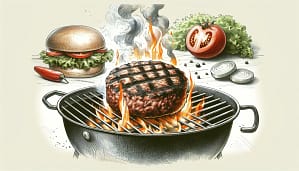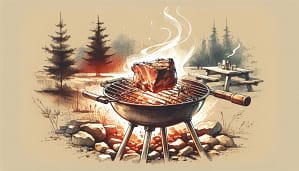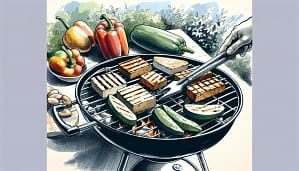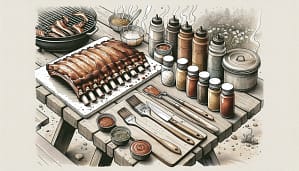How to Clean a Cast Iron Grill Pan: A Guide
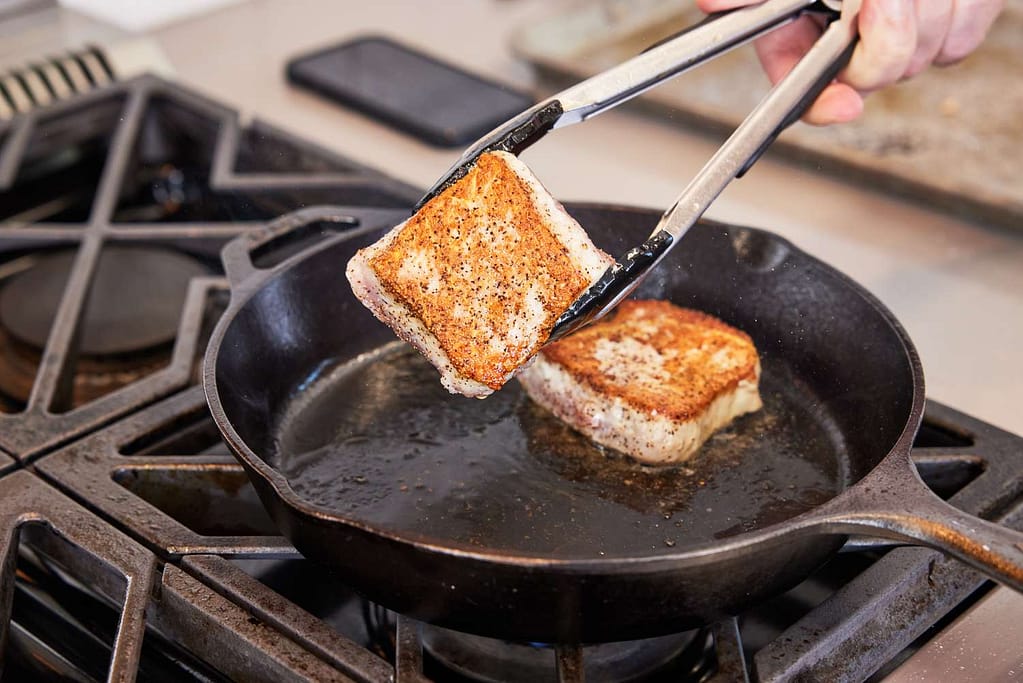
How to clean a cast iron grill pan? A few tips and tricks.
This guide covers everything you need to know about cleaning a cast iron grill pan. Is your pan burnt? Dirty? Keep reading and you’ll learn how to make it look brand new.
Introduction to Cleaning a Cast Iron Grill Pan
Cast iron grill pans are cherished for their durability and versatility in cooking, from searing meats to roasting vegetables. Maintaining the quality of your cast iron requires a specific cleaning approach that differs from other types of cookware. Proper cleaning and care ensure that your pan remains non-stick and free from rust, thereby extending its lifespan.
The Cleaning Process
The ideal time to clean your cast iron grill pan is shortly after cooking, while it is still warm.
Start by pouring out any leftover grease from the pan. If the pan is too hot to handle, let it cool slightly. But it should still be warm to ensure easier cleaning.
Using a stiff brush or a plastic scraper, remove food particles from the surface. Avoid using metal utensils or steel wool as these can scratch and damage the seasoning of the pan. For stubborn food residues, you can boil some water in the pan on the stove. The steam and heat help lift the food particles, making them easier to scrub away.
Once the solid particles are removed, rinse the pan under hot running water while scrubbing gently. Do not use soap as it can strip away the oil that constitutes the seasoning of the pan. If you must use soap, opt for a mild one and apply it sparingly.
After rinsing, dry the pan immediately with a clean towel. Leaving the pan wet can lead to rusting. To ensure it’s thoroughly dry, you can place it on a stove over low heat for a few minutes. This will help you to evaporate any remaining moisture.
How to Re-season Your Cast Iron Grill Pan After Grilling
Cleaning your cast iron may strip a small amount of oil off the surface. To maintain its non-stick properties, it’s important to re-season the pan after washing. Lightly coat the entire surface of the pan, including the handle and edges, with a high-smoke-point oil, such as vegetable oil or flaxseed oil. Use a paper towel to spread a thin layer evenly across the pan.
Place the oiled pan in an oven preheated to 375 degrees Fahrenheit for an hour. This process helps the oil to polymerize and form a protective layer. You’ll definitely want to make sure your kitchen is well-ventilated as this process can generate some smoke. After an hour, turn off the oven and let the pan cool inside until it reaches room temperature. This slow cooling process will help you do a better job solidify the seasoning.
Tips for Maintaining Your Cast Iron Pan
Regular maintenance of your cast iron grill pan is key to its longevity and performance. Store your pan in a dry place and if possible, with a paper towel inside to absorb any excess moisture. If your pan starts to show signs of rust, address it immediately by scrubbing off the rust with a mixture of salt and cooking oil, rinsing thoroughly, and re-seasoning as described.
Avoid cooking acidic foods, like tomatoes or vinegar-based sauces, in your cast iron pan as these can erode the seasoning more rapidly. Additionally, refrain from using harsh detergents or placing your pan in the dishwasher as these practices can compromise the integrity of the seasoning.
Conclusion
Taking proper care of your cast iron grill pan doesn’t just preserve its functionality; it enhances your cooking experience. Each cleaning and seasoning session contributes to building a better non-stick surface and a richer flavor in your cooked foods. By following these steps, your cast iron grill pan will remain a reliable companion in your culinary adventures for years to come.
FAQ
How to clean a Lodge cast iron pan?
Lodge, one of the prominent brands in cast iron cookware, recommends a specific routine to maintain the seasoning and integrity of their pans. You can get your own Lodge cast iron pan here.
Cleaning After Use
- Let the Pan Cool: Allow your Lodge cast iron pan to cool down to a manageable warmth after cooking to avoid thermal shock.
- Wipe Out Loose Food Particles: Using a paper towel or a non-metal brush, wipe away any loose particles of food. If bits remain stuck, you can use a pan scraper specifically designed for cast iron. Lodge produces its own scrapers, which are quite effective.
- Rinse with Warm Water: Rinse the pan under warm running water. You can use a brush or a non-abrasive scrubber to help remove any remaining food particles. Lodge pans are seasoned with oil at a high temperature to create a natural, easy-release cooking surface, which should be preserved by avoiding soap. However, it’s okay to use a small amount of soap if you feel it’s necessary, especially with newer Lodge pans which have a strong pre-seasoning.
- Dry Immediately: After rinsing, dry your pan immediately with a clean towel or place it on a heated stove to evaporate any remaining moisture. This step is crucial as leaving water on the pan can lead to rust.
Re-seasoning Your Lodge Cast Iron
If your pan was washed with soap or if food starts sticking to it, it might need a light re-seasoning. Here’s how you can do it:
- Apply Oil: After the pan is completely dry, apply a very thin layer of cooking oil to the entire surface of the pan, including the exterior and handle. Lodge recommends using mild vegetable oil or canola oil.
- Heat the Pan: Preheat your oven to 450-500 degrees Fahrenheit (232-260 degrees Celsius) and place the pan upside-down in the oven. Place a sheet of aluminum foil below the rack to catch any drips. Bake the pan for one hour.
- Cool the Pan: After the hour is up, turn off the oven and let the pan cool in the oven. This process helps the oil polymerize and form a new seasoning layer.
Ongoing Maintenance
- Avoid Cooking Acidic Foods Frequently: Cooking highly acidic foods (like tomatoes and citrus) can strip the seasoning off your pan. It’s fine occasionally, but regular cooking of such foods might require you to season more often.
- Store Properly: Store your Lodge cast iron in a dry place. If storing it in a location prone to moisture, place a paper towel inside the pan to absorb any humidity and prevent rust.
- Address Rust Immediately: If you notice any rust, scrub the rusted area with steel wool, rinse and dry the pan, and then re-season as described.
By following these guidelines, you can maintain the quality and performance of your Lodge cast iron pan, ensuring it remains a versatile tool in your kitchen for years.
How to Clean a Burnt Cast Iron Grill Pan?
Cleaning a burnt cast iron grill pan can be more challenging than regular maintenance, but with the right approach, you can restore its surface efficiently. Here’s a step-by-step guide on how to handle burnt residues and maintain the integrity of your cast iron grill pan.
Step 1: Allow the Pan to Cool
First, ensure the pan has cooled to a safe temperature to handle. Never quench a hot cast iron pan with cold water, as the sudden temperature change can cause the metal to warp or crack.
Step 2: Remove Loose Particles
Use a stiff brush or a plastic scraper to gently remove as much of the burnt-on food as possible. For grill pans with raised ridges, pay special attention to the grooves where food bits may be stuck.
Step 3: Boil Water in the Pan
If the residue is particularly stubborn, a good method is to boil water in the pan. Fill the pan with enough water to cover the bottom surface and bring it to a boil on the stove. The heat and steam will help loosen the burnt food. You can add a couple of tablespoons of salt to the boiling water to act as an abrasive.
Step 4: Scrub the Pan
Once the water has boiled for about a minute, pour it out carefully and use a brush or scraper again to scrub the pan while it’s still warm. Avoid using steel wool or metal brushes as these can damage the seasoning on your pan.
Step 5: Rinse and Check
Rinse the pan with hot water to check if there are any burnt areas remaining. Repeat the boiling process if necessary. Once the majority of the burnt food is removed, you can proceed to wash the pan with a small amount of dish soap and a scrub brush if needed. Normally, soap isn’t recommended for cast iron, but for severe cases, it can be used sparingly to remove burnt residues.
Step 6: Dry Thoroughly
After washing, dry your grill pan immediately with a towel. To ensure it’s completely dry, place it on a heated stove for a few minutes. This step is crucial to prevent rust.
Step 7: Re-season the Pan
After cleaning, your pan might need re-seasoning. To do this, coat the entire pan, including all cooking surfaces and the exterior, with a thin layer of cooking oil (vegetable oil, flaxseed oil, or shortening works well). Heat your oven to 375 degrees Fahrenheit (190 degrees Celsius), place the pan upside down on the top rack with a sheet of aluminum foil below to catch drips, and bake for 1 hour. Allow the pan to cool in the oven gradually.
